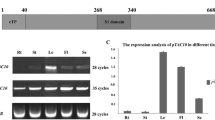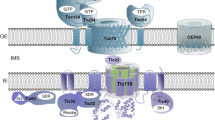Abstract
Using an 5′-AvaII fragment of the spinach (Spinacia oleracea L.) phosphate translocator cDNA as a probe for a hybridization screening of a pea (Pisum sativum L.) cDNA library we have cloned and sequenced a cDNA clone coding for the phosphate translocator precursor protein from pea chloroplasts. The full-length cDNA clone comprises 42 base pairs (bp) at the 5′-non-coding region, a 1206-bp coding region corresponding to a polypeptide of 402 amino-acid residues (relative molecular mass 43 671) and 244 bp at the non-coding 3′-region. Determination of the N-terminal sequence of the phosphate translocator from both pea and spinach chloroplasts revealed that the transit peptides consist of 72 and 80 amino-acid residues, respectively. These transit peptides are different from those of other chloroplastic transit peptides in that they both contain an amphiphilic α-helix which is located either in close proximity to the processing site in pea or at the N-terminus in spinach. The mature proteins from pea and spinach both contain about 87% identical amino-acid residues and about seven putative membrane-spanning α-helices. Some of these α-helices have an amphiphilic character and might serve to form a hydrophilic translocation channel through the membrane. The in-vitro synthesized pea precursor protein is directed to the chloroplast and inserted into the chloroplast envelope membrane.
Similar content being viewed by others
Abbreviations
- bp:
-
base pairs
- kDa:
-
kilodaltons
- Mr :
-
relative moleculas mass
- SDS-PAGE:
-
sodium dodecyl sulfate-polyacrylamide gel electrophoresis
References
Abad, M.S., Clark, S.E., Lamppa, G.K. (1989) Properties of a chloroplast enzyme that cleaves the chlorophyll a/b binding precursor protein. Plant Physiol. 90, 117–124
Benton, W.D., Davis, R.W. (1977) Screening λgt recombinant clones by hybridization to single plaques in situ. Science 196, 180–182
Bonner, W.M., Laskey, R.A. (1974) A film detection method for tritium-labelled proteins and nucleic acids in polyacrylamide gels. Eur. J. Biochem. 46, 84–88
Capaldi, R.A., Vanderkooi, G. (1972) The low polarity of many membrane proteins. Proc. Natl. Acad. Sci. USA 69, 930–93
Chirico, W.J., Waters, M.G., Blobel, G. (1988) 70 K heat shock proteins stimulate protein translocation into microsomes. Nature 332, 805–810
Cline, K., Werner-Washburne, M., Lubben, T.H., Keegstra, K. (1985) Precursors to two nuclear-encoded chloroplast proteins bind to the outer envelope before being imported into chloroplasts. J. Biol. Chem. 260, 3691–3696
della-Cioppa, G., Kishore, G.M. (1988). Import of a precursor protein into chloroplasts is inhibited by the herbicide glyphosate. EMBO J. 7, 1299–1305
Deshaies, R.J., Koch, B.D., Werner-Washburne, M., Criag, E.A., Schekman, R. (1988) A subfamily of stress proteins facilitates translocation of secretory and mitochondrial precursor polypeptides. Nature 332, 800–805
Douce, R., Holtz, B.R., Benson, A.A. (1973) Isolation and properties of the envelope of spinach chloroplasts. J. Biol. Chem. 248, 7215–7222
Dreses-Werringloer, U., Fischer, K., Wachter, E., Link, T.A., Flügge, U.I. (1990) cDNA sequence and deduced amino acid sequence of the precursor of the 37 kDa inner envelope membrane polypeptide from spinach chloroplasts: its transit peptide contains an amphiphilic α-helix as the only detectable structural element. Eur. J. Biochem. in press
Dunn, P.P.J., Packman, L.C., Pappin, D., Gray, J.C. (1988) N-terminal amino acid sequence analysis of the subunits of pea photosystem I. FEBS Lett. 228, 157–161
Flügge, U.-I. (1982) Biogenesis of the chloroplast phosphate translocator. FEBS Lett. 140, 273–276
Flügge, U.I. (1985) Hydrodynamic properties of the Triton X-100-solubilized chloroplast phospahte translocator. Biochim. Biophys. Acta 815, 299–305
Flügge, U.I. (1990) Import of proteins into chloroplasts. J. Cell Sci. 96, 351–354
Flügge, U.-I., Heldt, H.W. (1979) Phosphate translocator in chloroplasts: Identification of the functional protein and characterization of its binding site. In: Quagliariello, E., Palmieri, F., Klingenberg, E.M., eds. Function and molecular aspects of biomembrane transport, pp. 373–382 Elsevier/North Holland Biomedical Press, Amsterdam Netherlands
Flügge, U.I., Heldt, H.W. (1984) The phosphate-triose phosphate-phosphoglycerate translocator of the chloroplast. Trends Biochem. Sci. 9, 530–533
Flügge, U.I., Hinz, G. (1986) Energy dependence of protein translocation into chlorplasts. Eur. J. Biochem. 160, 563–570
Flügge, U.-I., Wessel, D. (1984) Cell-free synthesis of putative precursors for envelope membrane polypeptides of spinach chloroplasts. FEBS Lett. 168, 255–259
Flügge, U.I., Fischer, K., Gross, A., Sebald, W., Lottspeich, F., Eckerskorn, C. (1989) The triose phosphate-3-phosphoglycerate-phosphate translocator from spinach chloroplasts: nucleotide sequence of a full-length cDNA clone and import of the in vitro synthesized precursor protein into chloroplasts. EMBO J. 8, 39–46
Franzén, L.-G., Rochaix, J.-D., von Heijne, G. (1990) Chloroplast transit peptides from the green alga Chlamydomonas reinhardtii share features with both mitochondrial and higher plant chloroplast presequences. FEBS Lett. 260, 165–168
Gantt, J.S., Key, J.L. (1986) Isolation of nuclear encoded plastid ribosomal protein cDNAs. Mol. Gen. Genet. 202, 186–193
Gavel, Y., von Heijne, G. (1990) A conserved cleavage-site motif in chloroplast transit peptides. FEbS Lett. 261, 455–458
Grossman, A.W., Bartlett, S., Chua, N.-H. (1980) Energy-dependent uptake of cytoplasmically synthesized polypeptides by chloroplasts. Nature 285, 625–628
Hagemann, J., Robinson, C., Smeekens, S., Weisbeek, P. (1986) A thylakoid processing protease is required for complete maturation of the lumen protein plastocyanin. Nature 324, 567–569
Hartl, F.-U., Pfanner, N., Nicholson, D.W., Neupert, W. (1989) Mitochondrial protein import. Biochim. Biophys. Acta 988, 1–45
Henikoff, S. (1987) Unidirectional digestion with exonuclease III in DNA sequence analysis. Methods Enzymol. 155, 156–165
Hinz, G., Flügge, U.I. (1988) Phosphorylation of a 51 kDa envelope membrane polypeptide involved in protein translocation into chloroplasts. Eur. J. Biochem. 175, 649–659
Karlin-Neumann, G.A., Tobin, E.M. (1986) Transit peptides of nuclear-encoded chloroplast proteins share a common amino acid frame work. EMBO J. 5, 9–13
Keegstra, K., Olsen, L.J., Theg, S.M. (1989) Chloroplastic precursors and their transport across the envelope membranes. Annu. Rev. Plant Physiol. Plant Mol. Biol. 40, 471–501
Kyte, J., Doolittle, R.F. (1982) A simple method for displaying the hydropathic character of a protein. J. Mol. Biol. 157, 105–132
Laemmli, U.K. (1970) Cleavage of structural proteins during the assembly of the head of bacteriophage T4. Nature 227, 680–685
Lecker, S., Lill, R., Ziegelhoffer, T., Georgopoulos, C., Bassford, P.J., Jr., Kumamoto, C.A., Wickner, W. (1989) Three pure chaperone proteins of Escherichia coli — SecB, trigger factor and GroEL — form soluble complexes with precursor proteins in vitro. EMBO J. 8, 2703–2709
Lubben, T.H., Keegstra, K. (1986) Efficient in vitro import of a cytosolic heat shock protein into pea chloroplasts. Proc. Natl. Acad. Sci. USA 83, 5502–5506
Lubben, T.H., Theg, S.M., Keegstra, K. (1988) Transport of proteins into chloroplasts. Photosynth. Res. 17, 173–194
Pain, D., Blobel, G. (1987) Protein import into chloroplasts requires a chloroplast ATPase. Proc. Natl. Acad. Sci. USA 84, 3288–3292
Sanger, F., Nicklen, S., Coulson, A.-R. (1977) DNA sequencing with chain-terminating inhibitors. Proc. Natl. Acad. Sci. USA 74, 5463–5467
Schiffer, M., Edmundson, A.B. (1967) Use of helical wheels to represent the structures of proteins and to identify segments with helical potentials. Biophys. J. 7, 121–135
Schindler, C., Hracky, R., Soll, J. (1987) Protein transport into chloroplasts: ATP is a prerequisite. Z. Naturforsch. 42c, 103–108
Schmidt, P.E., Mishkind, M.L. (1986) The transport of proteins into chloroplasts. Annu. Rev. Biochem. 55, 879–912
Schreier, P.H., Senor, E.A., Schell, J., Bohnert, H.J. (1985) The use of nuclear-encoded sequences to direct the light-regulated synthesis and transport of a foreign protein into plant chloroplasts. EMBO J. 4, 25–32
Smeekens, S., Weisbeek, P. (1988) Protein transport towards the thylakoid lumen: post-translational translocation in tandem. Photosynth. Res. 16, 177–186
Smeekens, S., Bauerle, C., Hagemann, J., Keegstra, K., Weisbeek, P. (1986) The role of the transit peptide in the routing of precursors toward different chloroplast compartments. Cell 46, 365–375
Theg, S.M., Bauerle, C., Olsen, L.J., Selman, B.R., Keegstra, K. (1989) Internal ATP is the only energy requirement for the translocation of precursor proteins across chloroplastic membranes. J. Biol. Chem. 264, 6730–6736
van den Broeck, G., Timko, P.M., Kausch, A.P., Cashmore, A.R., van Montagu, M., Herrera-Estrella, L. (1985) Targeting of a foreign protein to chloroplats by fusion to the transit peptide from the small subunit of ribulose 1,5-bisphosphate carboxylase. Nature 313, 358–363
von Heijne, G. (1986) Mitochondrial targeting sequences may form amphiphilic helices. EMBO J. 5, 1335–1342
von Heijne, G., Steppuhn, J., Herrmann, R.G. (1989) Domain structure of mitochondrial and chloroplast targeting peptides. Eur. J. Biochem. 180, 535–545
Waegemann, K., Paulsen, H., Soll, J. (1990) Translocation of proteins into isolated chloroplasts requires cytosolic factors to obtain import competence. FEBS Lett. 261, 89–92
Webber, A.N., Packman, L.C., Gray, J.C. (1989) A 10 kDa polypeptide associated with the oxygen-evolving complex of photosystem II has a putative C-terminal non-cleavable thylakoid transfer domain. FEBS Lett. 242, 435–438
Zimmermann, R., Sagstetter, M., Lewis, M.J., Pelham, H.R.B. (1988) Seventy-kilodalton heat shock proteins and an additional component from reticulocyte lysate stimulate import of M13 procoat protein into microsomes. EMBO J. 7, 2875–2880
Author information
Authors and Affiliations
Additional information
We wish to thank Dr D. Pappin and R. Jakes (AFRC Sequencing Laboratory, Department of Biochemistry, University of Leeds, UK) for performing the N-terminal sequence determinations and are greatful to Dr J. S. Gantt (Botany Department, University of Georgia, Athens, USA) for a pea leaf cDNA library and to Professor J. C. Gray (University of Cambridge, Department of Botany, Cambridge, UK) for helpful discussions. This work was supported by the Deutsche Forschungsgemeinschaft, the Fonds der Chemischen Industrie, the Science and Engineering Research Council and the Royal Society. D.L.W. was the recipient of the Royal Society Rosenheim research fellowship and K.F. was supported by a fellowship from the Studienstiftung des deutschen Volkes.
Rights and permissions
About this article
Cite this article
Willey, D.L., Fischer, K., Wachter, E. et al. Molecular cloning and structural analysis of the phosphate translocator from pea chloroplasts and its comparison to the spinach phosphate translocator. Planta 183, 451–461 (1991). https://doi.org/10.1007/BF00197745
Received:
Accepted:
Issue Date:
DOI: https://doi.org/10.1007/BF00197745




